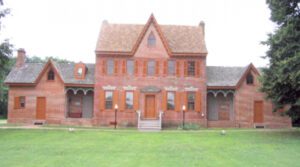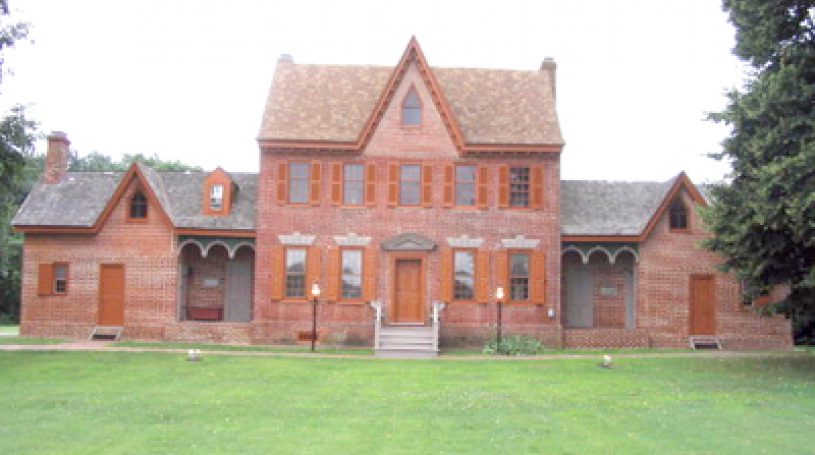

Milford Historical Society is seeking volunteers and trustees to help preserve the Parson Thorne Mansion.
Milford Historical Society, the organization that maintains and manages the Parson Thorne Mansion, one of the oldest structures in Milford, is looking for trustees and volunteers. Assistance is needed to support the historical society with operations, event planning and fundraising, as well as historical research and preservation work.
“Since our inception in 1961, our goal has been to preserve our local history and historic properties throughout Milford, not just the Parson Thorne Mansion,” said F. Brooke Clendaniel, Assistant Treasurer and a Trustee of the Society for 47 years. “I think we sometimes get confused with the museum, but we are completely separate organizations.”
The project of the preservation of the Parson Thorne Mansion on Silver Hill in Milford began in 1961.The founding of Milford Historical Society was the result of the offer of the gift of the mansion to the Captain Jonathan Caldwell Chapter of the DAR by James Richard Draper.
Miss M. Catherine Downing (later Mrs. T. Moore Holcombe, IV), Honorary State Regent and Past Vice President General, National Society Daughters of the American Revolution, was the local regent. She felt the project was too much for the local DAR members and asked if the offer would extend to a local historical society, if one was formed.
Mr. Draper and his parents, Mr. and Mrs. George H. Draper, Jr., agreed to extend that offer.
The Milford Historical Society was incorporated on December 12, 1961, by the original trustees: Miss Downing, the Rev. Dr. Edward John Dyer, then Rector of Christ Church, and Mr. Edward Millis Hurley.
“Now the mansion stands preserved on Silver Hill as a tribute to the generosity and labors of these people. Milfordians must always be grateful that this landmark has been saved,” Clendaniel said. “It is known both as the Silver Hill Mansion and as the Parson Thorne Mansion. Over the years the historic accounts in the 19th Century just assumed it was built by the Rev. Thorne. It was the home of one of Milford’s founders, the Rev. Sydenham Thorne, known colloquially as Parson Thorne; however, he was not the original owner. He was an ordained Church of England priest, who was sent by the Society for the Propagation of the Gospel in Foreign Parts in 1774 to be the first resident rector of the local parish, now Christ Episcopal Church in Milford.”
The files show the first meeting of the Milford Historical Society on February 12, 1962, and it was established that it would preserve, restore and maintain the mansion, protect other historic buildings in Milford, collect written records reflecting Milford history, operate a museum of Milfordiana as well as to promote and encourage interest in local history.
However, when the City of Milford decided to establish a museum in 1982, Downing felt it was better to have, in her words, “two separate and distinct” organizations, creating a City of Milford Landmarks and Museum Commission and leaving the Society just with the control of the mansion.
“We would like to become more involved in preserving other buildings throughout the city,” Clendaniel said. “There are so many that are at risk of being lost right now, for example the Vineyard Shipyard and the Mulholland Spoon Mill. It has always been my vision to create a living museum in Milford with the promotion of our history throughout the town. Some properties, like the Parson Thorne Mansion and the historic churches, are being preserved by organizations, but the majority of the properties are in private ownership. Our work needs to also encourage private restoration and rehabilitation of the buildings.
In addition to preserving the mansion, the historical society helped to create the National Register Historic Districts and with that listing a property may be eligible for federal tax credits for income producing properties.
“The City of Milford did designate city historic districts, but that was it,” Clendaniel explained. “The Society lobbied for actual historic district zoning classification and design review. The chair of the planning and zoning commission at the time scoffed at the idea, exclaiming, ‘We are not Williamsburg.’ Actually, the zoning classification and design review ordinance was based on the ordinances used in New Castle and Lewes. I regret that much has been lost in the subsequent years and I certainly know we are not Williamsburg. We are Milford and the rich fabric of our built environment reflects our history and what remains needs to be protected and preserved.”
Currently, the Society is raising funds to replace the roofs on various portions of the Parson Thorne Mansion. They also need funds to do continuously needed projects, some are classed as maintenance, but some are classed as capital improvements. Clendaniel would like to restore the interior of the small frame house, which was moved from near Greenwood to the property in 2007. It is a prime example of a small residential building from the late 18th / early 19th century period.
“We were fortunate to obtain the donation of that building, which was to be demolished. The exterior of the building has been restored, but the interior still needs work,” Clendaniel explained.
In addition, HVAC expansions are needed in order to renovate the plantation office and the kitchen in the main house, so they can be open to the public.
“We were criticized when the project of HVAC upgrades was done. We had to explain that climate control of temperature and humidity was not done for our personal comfort, but is vital to the preservation of the building and especially the historic artifacts on display,” Clendaniel said. “Until we expand the HVAC system into the wings, those rooms cannot have period furnishings and artifacts on display, including the east wing, which was the kitchen, and the west wing, which was the plantation office, would allow visitors the experience of visiting the entire home.”
Clendaniel explained that although all of these are relatively minor in a modern residence, to properly preserve the mansion requires both knowledge and expertise of artisans, who understand the construction of historic buildings, making the process a bit more difficult and a somewhat more costly. Explaining the need for continuous work on the brick exterior walls, Clendaniel continued that the mortar mix should match the original with the proper proportion of crushed oyster shells.
“And that mix is not available off the shelf at your local big box home improvement store,” he stated. “We cannot use modern mortar as the modern version contains cement and the old bricks are soft. Old bricks need a soft mortar, so as not to crumble. That also requires constant mortar repointing.”
Another project Clendaniel would like to see on the property is the construction of a barn-style visitor’s center that would include public restrooms, exhibit space, a meeting room, as well as office space for staff and volunteers.
“This needed building would also allow rooms in the Mansion to be used for exhibition and not storage space,” Clendaniel said. “Our goals are ambitious, which is why we need help.”This rich history must be preserved. We could create a thriving historical destination for visitors to Milford. That economic boost of tourism can all begin with this old mansion.”
Anyone interested in assisting the Milford Historical Society can contact [email protected] or direct contributions for the preservation of local history can be made through a tax-deductible donation to the Milford Historical Society. Checks can be sent to the Milford Historical Society at P.O. Box 352 Milford DE 19963-0352. Online donations can be made by visiting degives.org/orgs/milford-historical-society.
RELATED STORIES:
Share this Post



